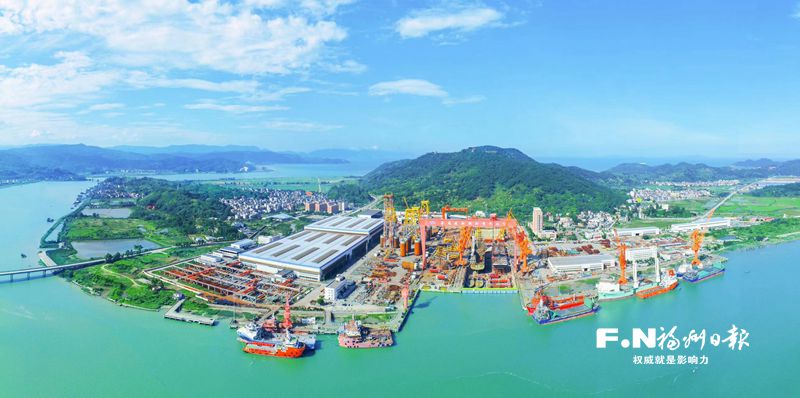The ocean blocks communication, but with the continuous development of marine equipment and technology, people sail cross the ocean to exchange and interact, and create brilliant marine civilization. On October 13, the sub-forum of the World Marine Equipment Conference-the Forum of World Marine Civilization Exchange and Mutual Learning was held in China Shipbuilding Culture City. Experts of marine culture research from China, the US, France, Malaysia and other countries got together to share cases and open a new perspective to understand the world marine civilization.

Culu island shipbuilding base at the mouth of Minjiang River.Photographed by reporter Lin Shuangwei
Discover the footprint of marine civilization from brewing
Can we find the footprint of marine civilization from the brewing? According to Liu Li, a professor of East Asian Language and Culture at Stanford University, the answer is positive.
“In recent years, the Archaeological Center of Stanford University has made morphological identification and comprehensive analysis of micro-plants and microorganisms in pottery residues by using optical microscope, and has achieved important research results.” Liu introduced that in the middle Neolithic period, the brewing methods in various parts of China showed regional characteristics, with Dawenkou culture as the representative in the eastern coastal areas and Yangshao culture as the representative in the western inland areas, respectively showing the social value tendency of taking individuals as the standard and taking the collective as the standard. During this period, the brewing tradition also spread to the surrounding areas.
In the middle and late Neolithic period, the primitive Austronesian-spoken group crossed the strait and arrived in Taiwan to form the Dakengkeng culture. “The type of pottery ware in Dagukeng is very close to that in Fujian and Guangdong coastal areas, so it is speculated that the brewing method should also spread to Taiwan during this period.” Liu said, “The ethnic minorities in Taiwan have preserved rich traditional brewing methods so far, and their ethnological data on brewing and drinking have played an important role in restoring the prehistoric wine culture tradition in China. We are prepared to discuss this topic in depth.”
Development of shipbuilding and navigation technology promotes win-win situation
Fujian has developed shipbuilding industry since ancient times. As early as the pre-Qin period, the ancestors of Fujian people who lived in now Fujian began to build ships. During the Song and Yuan Dynasties, with the prosperity of overseas trade, Fujian became one of the most important shipbuilding bases in China.
“During the Ming and Qing Dynasties, due to the special geographical relationship, Fujian occupied an unusual position in the history of exchanges between Ryukyu and the mainland in the Ming and Qing Dynasties.” Lai Zhengwei, a professor at the School of Social History of Fujian Normal University, said that Ryukyu is located on an island, and its foreign exchanges depend entirely on boats. Fujian has always developed overseas transportation and trade, so the exchange of shipbuilding and navigation technology between Ryukyu and Fujian has become a prerequisite for exchanges between the two places.
With the passage of time, Fujian’s advanced shipbuilding and marine technology has been continuously introduced into Ryukyu through various channels, which has greatly promoted the development of Ryukyu’s overseas transportation and intermediary trade. On the other hand, this exchange has also promoted the improvement of shipbuilding technology and the prosperity of commodity economy in Fujian.
The improvement of shipbuilding and marine technology has also promoted the trade exchanges between China and Britain. Louise Macfarlane, librarian of the Royal Museum in Greenwich, England, introduced the development of British tea clippers in the 1960s and 1970s. She especially mentioned that the “Tea Competition” which started from Fuzhou in 1866 was the symbol of its climax. As one of the most famous tea clippers in history, the Cutty Sark visited Fuzhou in 1871. The process was recorded by ship logs, newspapers, correspondence of the Ministry of Foreign Affairs, genealogical documents and other materials at that time.
Fujian merchants promote the development of Southeast Asia
In the 17th and 18th centuries, Fujian merchants moved from one port to another and became active in Southeast Asia. In order to meet the demand of China and Europe for minerals and tropical agricultural products, Fujian merchants based in ports began to invest in mining and planting in Southeast Asia.
“Due to the trade network and capital expansion of Fujian merchants, the number of Chinese in Southeast Asia experienced unprecedented growth in the 18th century.” Huang Yuduan, deputy dean of the Graduate School of New Era University College in Malaysia, said that the existence of Fujian merchants’ settlements and their commercial networks has played a vital role in the development of Southeast Asian ports and coastal hinterland.
However, at the end of the 18th century, influenced by political turmoil, Fujian merchants who were active in Southeast Asia began to migrate from big ports to small ones. Huang took Penang and Kuala Terengganu in Malaysia as examples, and introduced how Fujian merchants in Nanyang organically connected the two seaports and their neighboring shopping malls at that time to build a trade area.
Huang said that the trade activities and trade networks of Fujian merchants are not limited to a single group, nor to a country or a place, but a mechanism that spans a wide range and integrates other families, companies, social parties and enterprises horizontally, while integrating them vertically with the grassroots. Obviously, Fujian merchants played a leading role in Nanyang, connecting and integrating the most important elements of regional economy at that time, such as labor, capital, organization, politicians and merchants.
(Fuzhou Daily reporter Feng Xuezhu)